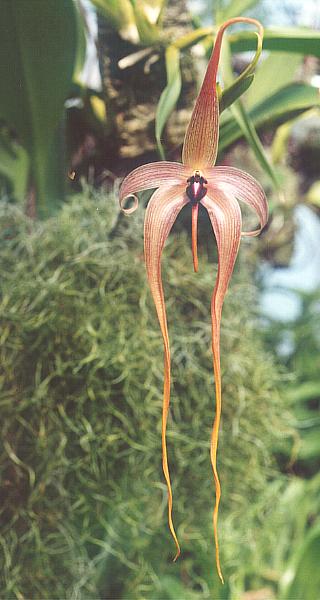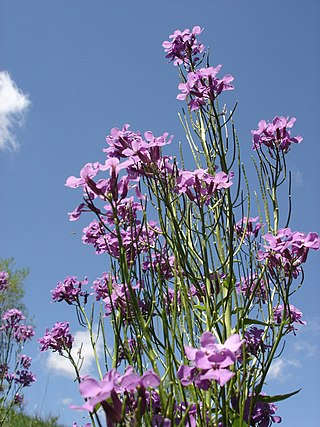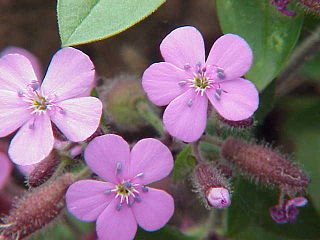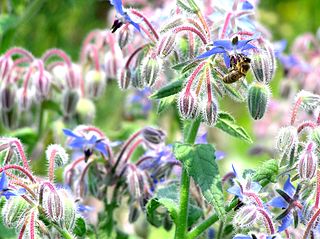
Boraginaceae, the borage or forget-me-notfamily, includes about 2,000 species of shrubs, trees, and herbs in 146 to 154 genera with a worldwide distribution.

Bulbophyllum is a genus of mostly epiphytic and lithophytic orchids in the family Orchidaceae. It is the largest genus in the orchid family and one of the largest genera of flowering plants with more than 2,000 species, exceeded in number only by Astragalus. These orchids are found in diverse habitats throughout most of the warmer parts of the world including Africa, southern Asia, Latin America, the West Indies, and various islands in the Indian and Pacific Oceans. Orchids in this genus have thread-like or fibrous roots that creep over the surface of trees or rocks or hang from branches. The stem is divided into a rhizome and a pseudobulb, a feature that distinguished this genus from Dendrobium. There is usually only a single leaf at the top of the pseudobulb and from one to many flowers are arranged along an unbranched flowering stem that arises from the base of the pseudobulb. Several attempts have been made to separate Bulbophyllum into smaller genera, but most have not been accepted by the World Checklist of Selected Plant Families.

Cytisus is a genus of flowering plants in the family Fabaceae, native to open sites in Europe, western Asia and North Africa. It belongs to the subfamily Faboideae, and is one of several genera in the tribe Genisteae which are commonly called brooms. They are shrubs producing masses of brightly coloured, pea-like flowers, often highly fragrant. Members of the segregate genera Calicotome, Chamaecytisus, and Lembotropis are sometimes included in Cytisus.

Hesperis is a genus of flowering plants in the family Brassicaceae. Most are native to Eurasia, with several endemic to Greece and Turkey. Many plants of this genus bear showy, fragrant flowers in shades of purple and white. One of the more widely known species is the common garden flower Hesperis matronalis. The genus name Hesperis was probably given because the scent of the flowers becomes more conspicuous towards evening.

Saponaria is a genus of flowering plants in the family Caryophyllaceae, native to Asia and Europe, and are commonly known as soapworts. They are herbaceous perennials and annuals, some with woody bases. The flowers are abundant, five-petalled and usually in shades of pink or white. The genus is closely related to the genus Silene, being distinguished from these by having only two styles in the flower. It is also related to Gypsophila, but its calyx is cylindrical rather than bell-shaped.
Taner Sağır is a Turkish world and Olympic weightlifting champion. Coming into Athens as holder of all the junior world records at the age of only 19, he broke the Olympic records in the category –77 kg snatch, clean and jerk and total. He is seen as a great talent by authorities.

The genus Anchusa belongs to the borage family (Boraginaceae). It includes about 35 species found growing in Europe, North Africa, South Africa and Western Asia. They are introduced in the United States.

Isatis is a genus of flowering plants in the family Brassicaceae, native to the Mediterranean region east to central Asia. Its genus name, Isatis, derives from the ancient Greek word for the plant, ἰσάτις. The genus includes woad. Due to their extremely variable morphology, the Asian species in particular are difficult to determine; the only reliable diagnostic feature is the ripe fruit. They are (usually) biennial or perennial herbaceous plants, often bluish and hairless or downy hairy with the upright stem branched.

Manisaspor Kulübü is a Turkish professional football club located in the city of Manisa. Originally formed in 1931 as Sakaryaspor, the club changed its name to Manisaspor on 15 June 1965. The club colours are red, white, and black. Manisaspor play their home matches at Manisa 19 Mayis Stadi.

Arenaria is a genus of flowering plants, within the family Caryophyllaceae.

Cynoglottis barrelieri, Barrelier's bugloss or false alkanet, is a species of flowering plant in the Boraginaceae family. It is a perennial native to southeastern Europe, Crimea, Turkey, Lebanon, and Syria. It is sometimes used as an ornamental plant.

Boraginoideae is a subfamily of the plant family Boraginaceae s.s, with about 42 genera. That family is defined in a much broader sense in the Angiosperm Phylogeny Group (APG) system of classification for flowering plants. The APG has not specified any subfamilial structure within Boraginaceae s.l.

Sesleria is a genus of perennial plants in the grass family. They are native to Eurasia and North Africa. They are found in Albania, Austria, Baleares, Baltic States, Belarus, Belgium, Bulgaria, Corsica, Czechoslovakia, East Aegean Islands, Finland, France, Germany, Great Britain, Greece, Hungary, Iceland, Iran, Ireland, Italy, Crete, Crimea, Lebanon, Morocco, North Caucasus, Poland, Romania, Sardina, Sicilia, Spain, Sweden, Switzerland, Syria, Transcaucasus, Turkey, Ukraine and Yugoslavia.

Chaenorhinum is a genus of flowering plants. It includes 27 species of annual and perennial herbs native to the Mediterranean Basin, Europe, and western Asia to the western Himalayas. They thrive in dry stony areas and scree. They are closely related to snapdragons. The leaves are linear to oblong or rounded, opposite at the base. The flowers resemble snapdragons, being typically zygomorphic, hooded, lobed and spurred. They are borne in terminal racemes or singly in the leaf axils of the branching stems.
Vuralia is a monotypic genus belonging to subfamily Faboideae of the legume family, Fabaceae, endemic to the area surrounding lakes Akşehir and Eber in southwestern Türkiye. It has a chromosome number of 2n = 18. The single species Vuralia turcica was discovered by Turkish botanists in 1982 and is found only on the shores of lakes Akşehir and Eber. The species is critically endangered, being on the verge of extinction in its native range. The local names of this species translate as Eber yellow and yellow licorice. V. turcica was formerly placed in the genus Thermopsis.

Diarthron is a genus of flowering plant in the family Thymelaeaceae. The precise limits of the genus are uncertain. When broadly circumscribed to include Dendrostellera and Stelleropsis, it consists of annual and perennial herbaceous plants and small shrubs, with reddish, white or green flowers lacking petals, and is found in central and south-west Asia and south-east Europe.
Hypericum fissurale, known as cracked St. John's wort, is a flowering plant in the St. Johns's wort family (Hypericaceae) endemic to northeastern Turkey. It is considered critically endangered on the IUCN Red List due to its very limited distribution and declining population. It was first formally named by Jurij Nikolaewitch Woronow in 1912. It is a small perennial herb in the section Hypericum sect. Taeniocarpium, reaching around 22 cm (8.7 in) in height. Like most Hypericum species, it has flowers with five yellow petals and numerous stamens. Hypericum fissurale is closely related to Hypericum armenum.
Hellenocarum is a genus of flowering plants belonging to the family Apiaceae.
Lutzia cretica is a species of herbaceous plant endemic to the Aegean Islands of Greece. It is the only species in the genus Lutzia, which belongs to the cabbage family Brassicaceae.
Delphinium iris is a species of flowering plant within the genus Delphinium and the family Ranunculaceae.













